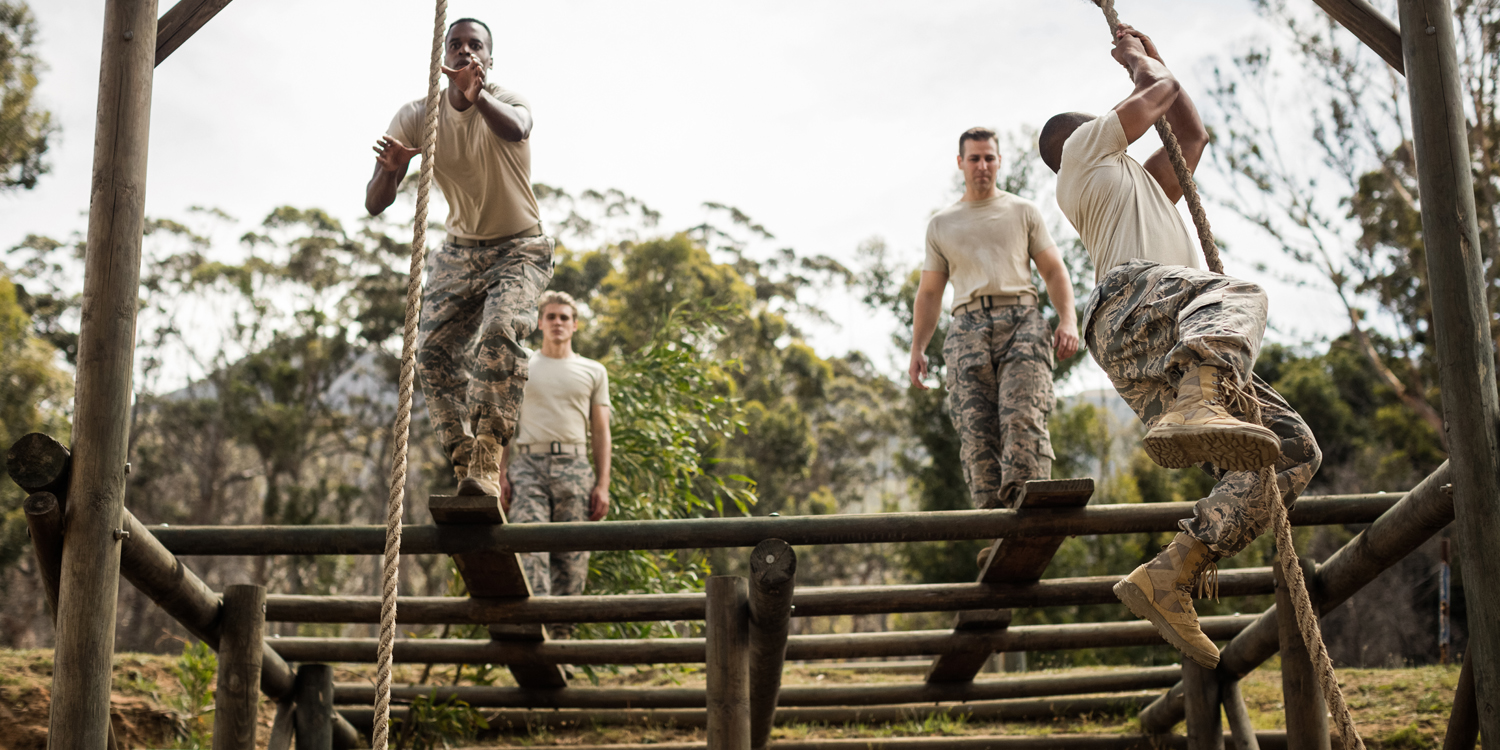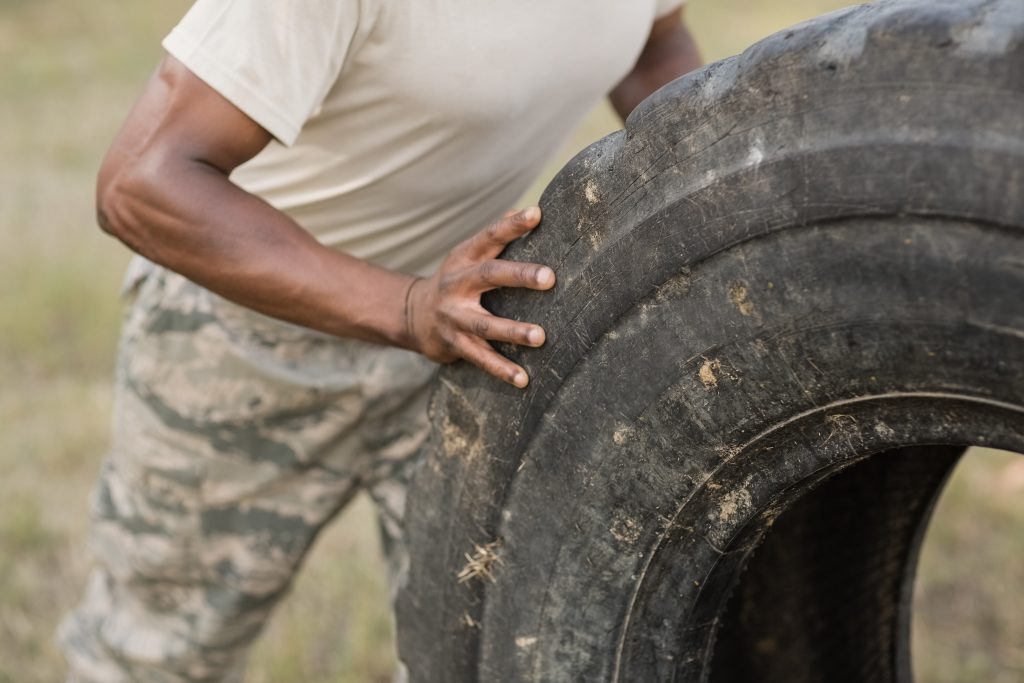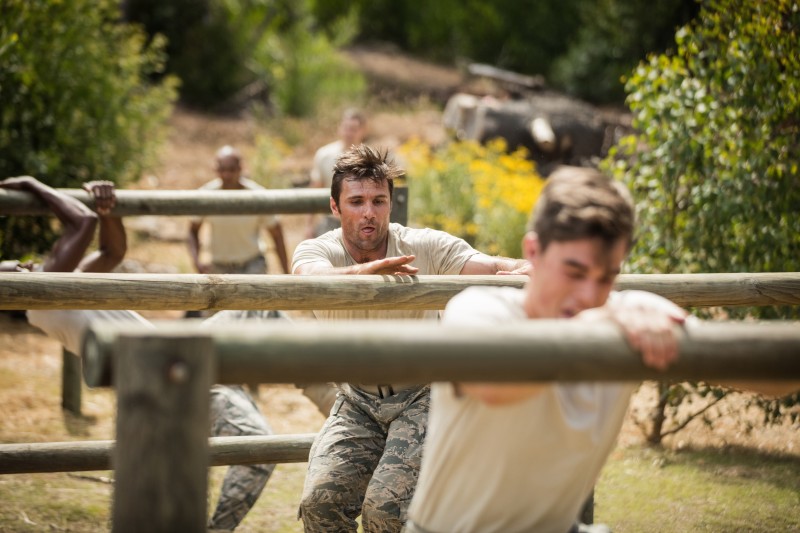
Coauthord by Willie Danzer and Brian Sklenar
For the first time in a while, new strength and conditioning jobs are being created on a large scale, presenting viable competition to athletics in the strength and conditioning job market. That is, within the tactical sector. Starting roughly 10 to 15 years ago, creating a program in the image of a collegiate performance staff began within the special operations segments of the different branches of the United States Military. This program consists of strength and conditioning, sports medicine, and sports nutrition housed under one roof. Recently, conventional forces within the military branches have created their own program in the model of the one created for special operations, which is the program that is currently experiencing the most growth.
RELATED: John Carroll University ROTC Seminar — Powerlifting as Military Training
As the tactical sector of strength and conditioning grows, so does the awareness, curiosity, and interest from coaches currently in athletics. There is some mystery within the strength and conditioning community about what exactly these jobs entail, what to expect from them, and why someone may want to pursue a job on this side. This article will primarily focus on coaches currently in athletics and will have two major aims. First, it aims to bring awareness to the tactical sector as a career option within the profession for those coaches that didn’t previously know of the existence of these programs. Secondly, for those coaches that are curious or interested in a job within the tactical sector, we will try to show some of the major differences between athletics and military sectors. In doing so, we hope to also magnify the major commonalities of being a strength and conditioning coach in both settings. Our goal is to write the article we wanted to read when transitioning from a combined two decades of experience in athletics to this new environment.
Levels Within Military Strength and Conditioning
Before delving into the similarities and differences between military and athletics, the one major piece of context that needs to be stated is how varied many of the details of experience are within military strength and conditioning. At the biggest level, there will be differences between branches of the military and differences between working with special operations, conventional forces, school-house, or group/unit. As you continue to zoom in to smaller levels, more details of difference emerge. For this reason, we will try to only discuss those commonalities of experience we believe are most applicable. This will lead to speaking in generalities and, as with anything, there will be exceptions. For your understanding of where we are coming from, our own specific experience is within special operations at the schoolhouse level.
Environment
The first thing you’d notice if you walked into our weight room during training hours is that the environment is much different than what most would probably expect. It doesn’t look like a basic training or college football atmosphere. At least not in special operations. The soldiers aren’t showing up ten minutes early wearing matching clothes with their shirts tucked in. There’s not a bunch of yelling, and no one is trying to drill in discipline and mental toughness. Instead, what you’d see is a bunch of professionals dressed the way they want, training in a workman-like manner. Our role with them is more as a resource rather than a hierarchical leadership figure. This is probably the biggest misconception we run into. There are exceptions, of course, but this is the majority of our experience.

Age
One of the major differences between working with soldiers and athletes, especially when coming from collegiate athletics, is age. The age range tends to vary to a greater degree. You could be working with 18-year-olds right out of high school, officers in their 50s, and everything in between. In special operations, the age right out of selection tends to be higher than rookies in professional sport. The average career of an operator tends to be longer than the average career in most professional sports. This creates a population that is older on average, and where the oldest (not including officers) are in their 40s. Partially because of this, the average maturity of the soldiers is higher than what would typically be experienced in college athletics. Many of them, with families and/or responsibilities, are in a different place in life.
Interaction with soldiers on the floor can also be slightly different from athletics, although not as much if you are used to working with professional athletes. The age and maturity of many soldiers, as well as the professionalism of the environment, lends itself more towards conversational coaching. We’re helping rather than dictating. Most will take coaching as help and will be appreciative for it. If they are coming into the facility voluntarily, it’s because they want your coaching.
Self-Motivation
The soldiers, on average, are more self-reliant and more self-motivated than the average collegiate athlete. More often than not, they don’t want or need a coach breathing down their neck the entire session. As the subject-matter expert, you don’t need to lead every session. We have noticed that soldiers seem to enjoy a degree of autonomy even more than most athletes. Letting them have input in their program, or even just allowing them to have a say in exercise selection, goes a long way.
With all of those differences said, the basics of coaching will not change—interpersonal skills are still applicable. Having a coaching style that is based on your personality and being genuine is still very important here. Putting in effort goes a long way towards getting buy-in, as does having the ability to be approachable and partake in casual conversation.
Injuries
One noticeable difference on the physical end is the nature of injuries. There are injuries we’ve encountered working with soldiers that we never ran into in athletics and some injury mechanisms that were also a first for us. To a large part, the latter is attributed to the nature of the actual military job functions or training. The differences in the populations, however, are only of concern if relying exclusively on past experience.
The body, and the effects of stress and load, remain unchanged. When presented with new injuries with new mechanisms, functional anatomy and the corresponding programmatic decisions and rehab prescriptions you relied on in athletics will serve you well in this setting. This is no different than the research process that would be undertaken when encountering a new injury when starting to work with a sport you had no previous experience with. Further, doing your due diligence to mitigate controllable injuries will involve the same analytical process done in athletics to mitigate common injuries respective to a specific sport.
Programming
When first transitioning from athletics to the tactical setting, the biggest questions we had surrounded programming. Luckily, the only real differences lie in the context of the populations. One of those contexts is temporal considerations. Everything in athletics revolves around a rigid yearly schedule with hard dates of various importance (pre-season camp, season, off-time, off-season, spring ball, etc.). On the tactical side, timeframes can range to a greater degree and be more fluid.
If you're working with students, you might run into an in-and-out process where you see the students during some phases and not others. Further, the length of each phase may be different. At some points, you may only see them for a couple of weeks, other times several months. In some courses, you might have the students the entire length of the course in the weight room. In other courses, you may only be programming and spot-checking while the cadre run the day-to-day in the field. You could have a soldier doing a train-up program to prepare for an advanced school or advanced selection where you might have anywhere from a couple of months to a year to prepare. The time you have in this regard is dependent on how early or late the soldier decided to go for that school or selection, or if it is decided to move the date of the school/selection for any reason. Similarly, you will have a certain amount of months to specifically prepare for a deployment based on the region of deployment and mission set. You could have an officer, cadre, or permanent party member that has no hard timeframe to base programming on.
These represent the most general, common examples to illustrate how wide-ranging and fluid schedules are on the tactical side. While the wide range of time periods was a little different initially, the lack of a real annual calendar and indefinite time frames were the most strange.

Training Goals
The training goals may be just as varied depending on location and population within the military setting. For students, place within selection or school can dictate the direction of training due to the demands of the current phase and the requirements for the next phase. The training of graduating students will be more aimed towards what the groups will require when they get there. The training of deployable soldiers may differ based on where they are at in their deployment cycle. Train-ups for advanced schools and selections will require different training than “normal programming,” and will be more singularly focused on the demands of the specific school/selection. Once past student level, a further separation of training goals can occur due to a host of other factors, including individual goals, individual injury history, personal preference, etc. There are also times when some soldiers’ training goals don’t necessarily coincide with their career path. For instance, it isn’t uncommon to talk to a soldier looking for a program to prepare them for a triathlon, marathon, powerlifting meet, or some other sport. All of this requires a little more flexibility and understanding when providing programming that satisfies both what the soldier needs and wants.
The wide age range and array of injuries being presented are two factors to consider when programming for the soldiers. It is also important to consider training age and training background. Generally speaking, the soldiers seem to know more about training than the average college athlete or have been exposed to a more diverse set of training styles/programs. For a rough comparison from collegiate athletics, it’s like working with senior transfers.
Quality of Life and Longevity
Performance is still important in the tactical sector. Physical development is important to the performance of their job in the field and is also necessary for testing. Training for a specific job or role may specialize the training, and so will the specifics of an upcoming deployment direct the program. While PT tests shouldn’t take on the same importance as job/deployment/task-specific training, they are a part of reality for the soldier. Meeting and exceeding PT test standards is part of getting into and through selections and schools, and certain standards must be maintained for career advancement. While a focus on performance is a commonality between athletics and tactical strength and conditioning, quality of life and longevity take on even more importance here than it does athletics for a variety of reasons.
Even though some of the variables of the training are different with the military compared to athletics, the principles of training remain the same. The contextual analysis of the soldier and his or her needs does not change even if the details of context do. The subsequent process of selecting a programmatic structure, block sequencing, methods, means, and progressions based on the contextual analysis will also be familiar to those coming from athletics. The most important takeaway from illustrating all the differences in contextual details between the athletic and tactical sectors is that the mechanics of the profession remain. With that in place, those that are adept at analytical and critical thinking will find the job comfortingly familiar, a chance to pivot the focus of their skillset rather than an environment that demands the development of a new skill set entirely.
Why Pursue a Job in Military Strength and Conditioning?
With all of the information presented to this point, the big question is why pursue a job in military strength and conditioning? Well, the first reason would be quality of life. This is a phrase tossed around quite a bit in athletics, with little action being taken to actually make a noticeable difference. With our positions being contractor positions, our hours are much more in line with what would be considered normal weekly work hours. There’s more time at home with family, and work rarely follows you home as it does in athletics. And while every job has stress, this job being no exception, we personally have found the kind of stress experienced here to be much more benign than what we experienced in athletics.
Stepping into the tactical sector provides new avenues for personal growth. The different variables and scenarios encountered will help spur new personal research and new coaching experiences to add to the proverbial toolbox. In most cases, your directives from command will be given in the form of goals, and it is up to you to figure out how to accomplish those goals. There is the freedom to be creative and the space to put your own personal touches on the work you do. For the most part, you can make of it what you wish.
If being on the ground floor of something is appealing, then that is another benefit that this side can provide. With these programs being so young, even within a larger profession that is relatively young in and of itself, the opportunity exists to play a part in the direction and quality of a developing program if you so choose. This is especially true within the conventional forces program where, in some instances, entire departments are being created from scratch at certain units.
While there are many more reasons why someone might want to pursue a tactical job, which will be individual to each coach, the last one we will list is the most important to us. That is the opportunity to give back to soldiers by using our knowledge and abilities to assist in their physical development and longevity. Personally, many of our experiences here are among the most meaningful and rewarding in our careers.
Every job has its positives and negatives. Every coach has their own personal interests and motivations within this field, which ebbs and flows throughout a career. A job within tactical strength and conditioning may be right for you at this moment. Maybe it will be at another time down the road, maybe it never will. For most of us, we got into this profession because of athletics, and we personally enjoyed our time in it. This has allowed us to see the positives and negatives of each. We hope that we presented the tactical sector as one more viable option within the field. If you were already considering a move to the tactical sector, or had an interest in it, we hope we were able to provide some clarity to your decision one way or the other. We assure you that while there are differences working with soldiers, the biggest and most important aspects of coaching remain the same. If you decide to start applying, here's a tip: start brushing up on your acronyms.
Image credit: Wavebreak Media Ltd © 123rf.com
Willie Danzer completed his undergraduate degree at the University of Northern Iowa in 2008, receiving a bachelor of science degree in physical education. He received his master’s degree from Northwestern State University in Louisiana in sports administration while serving as an assistant coach for five Division 1 sports. He then served as the head Olympic sports strength and conditioning coach at Youngstown State University before working as the assistant strength coach for Olympic sports at James Madison. Willie started working as a tactical strength and conditioning coach in 2015. He holds multiple certifications within the field of strength and conditioning and has been a certified strength and conditioning coach since 2008.
Brian Sklenar received his bachelor’s degree from Youngstown State University. He spent eight years at Youngstown State starting as a student assistant and worked his way up through the department, eventually being named director of strength and conditioning. Previous to that, he was an intern with the University of Pittsburgh’s football physical preparation staff. Brian spent ten years in collegiate strength and conditioning before moving into the tactical setting in 2019.










It varies per unit or station, I can tell you where we work there have been interns for S&C in the past. Many times they have some relation to military personnel or have prior service which makes the screening process much easier. I will tell you the biggest snag we run into with interns is the qualification process. Many times what the qualification requires tends to turn applicants off because they will not be able to go directly into the field. Feel free to reach out and we can speak more on the subject.